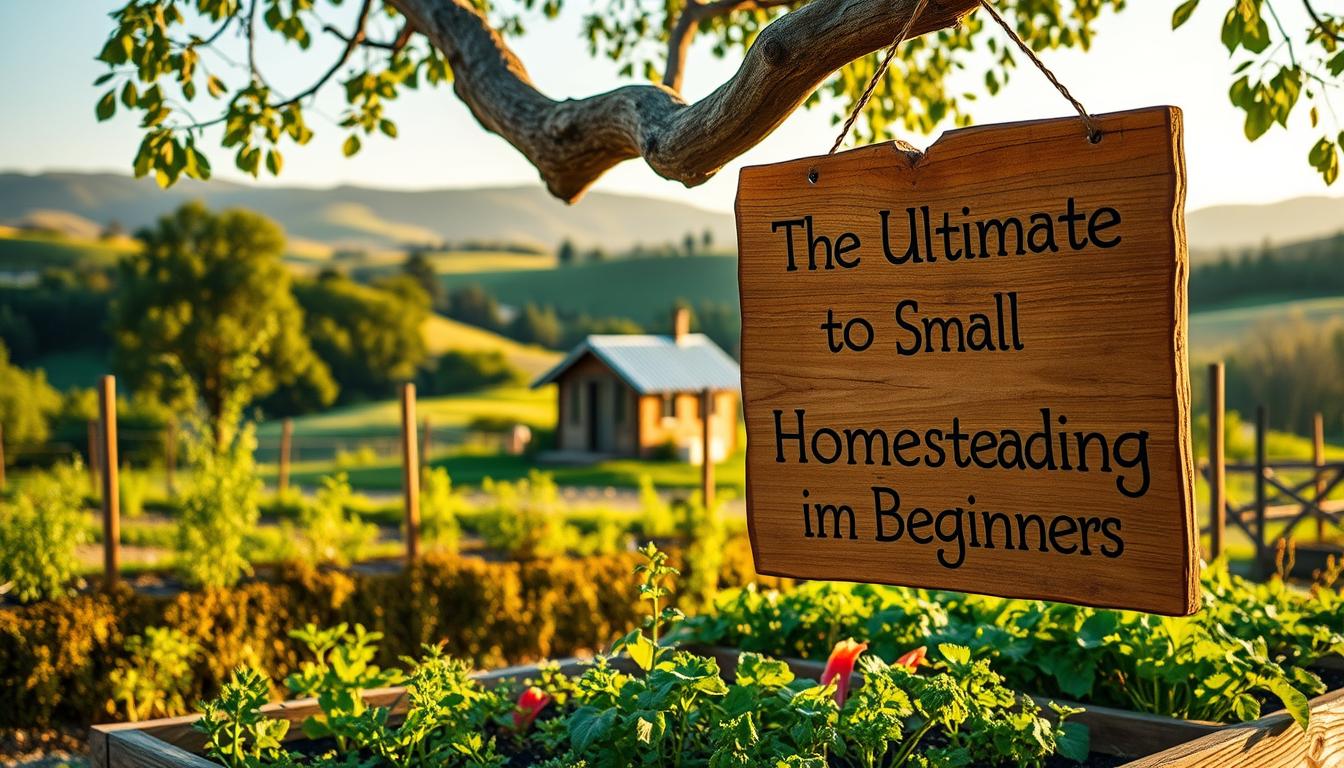Homesteading has evolved from a fringe lifestyle to a mainstream movement, with 75% of practitioners being first-generation. This modern approach to self-sufficiency is more accessible than ever, making it perfect for beginners. Whether you’re transitioning from suburban life or starting fresh, this guide will help you navigate the essentials.
Many people believe homesteading requires vast amounts of land, but that’s not the case. A manageable 5-acre property can serve as an ideal starting point. From container gardens to micro-livestock, the “start small” philosophy ensures you can achieve self-sufficiency without feeling overwhelmed.
Interest in this lifestyle has surged by 200% since 2020, proving its growing appeal. Whether you’re looking to grow your own food, raise animals, or live sustainably, homesteading offers a rewarding path for beginners.
Key Takeaways
- 75% of homesteaders are first-generation practitioners.
- A 5-acre property is ideal for manageable self-sufficiency.
- Misconceptions about land requirements often deter beginners.
- Homesteading interest has grown by 200% since 2020.
- Starting small with container gardens and micro-livestock is practical.
What is Small Homesteading?
Self-sufficiency today doesn’t require endless acres but smart use of limited space. Modern homesteading focuses on 1-5 acre properties, making it accessible for beginners. Unlike traditional farming, which relies on industrial equipment, this approach emphasizes human-scale infrastructure.
Historically, U.S. homesteads spanned 160 acres. Today, a 5-acre property is often enough to achieve self-sufficiency. This shift reflects a growing trend toward sustainable living and efficient land use.
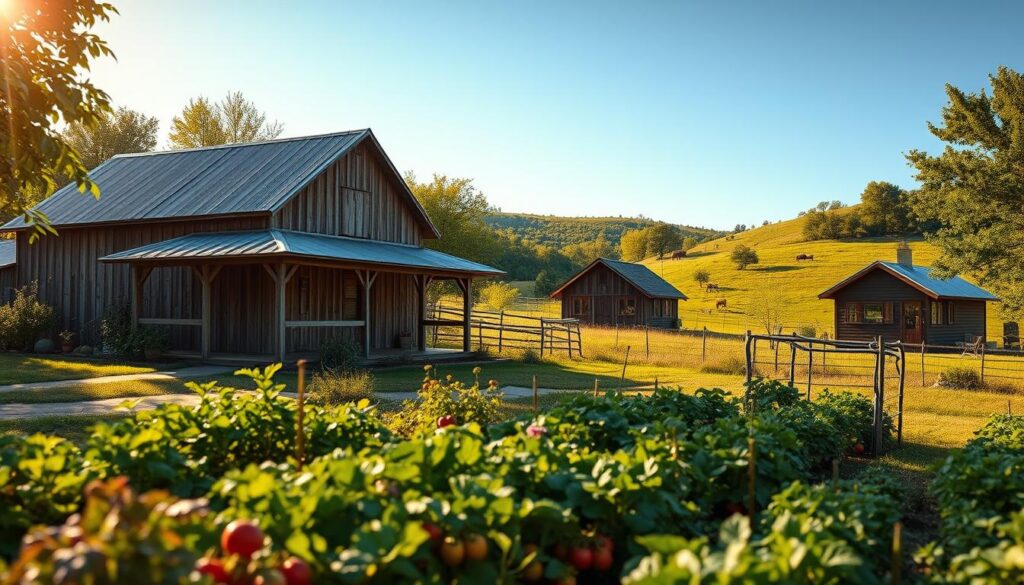
Zoning laws play a crucial role, especially for suburban homesteads. Before starting, check local regulations to ensure your plans align with the rules. This step can save you time and avoid potential legal issues.
Vertical integration is another key concept. For example, a 1/4 acre self-sufficient garden can produce enough food for a family. Techniques like vertical gardening and companion planting maximize productivity in limited space.
Urban adaptations are also gaining popularity. Balcony herb gardens and apartment quail coops prove that you don’t need a large property to embrace this lifestyle. These innovations make homesteading feasible for city dwellers.
- Modern homesteading focuses on 1-5 acre properties.
- It emphasizes human-scale infrastructure over industrial equipment.
- Zoning laws are critical for suburban homesteads.
- Vertical integration maximizes productivity in limited space.
- Urban adaptations like balcony gardens make homesteading accessible.
Why Start a Small Homestead?
Embarking on a self-sufficient lifestyle offers countless benefits for both individuals and families. For many, the primary motivator is food security. In fact, 68% of homesteaders cite this as their main reason for starting. Growing your own food ensures you know exactly what’s on your plate, free from harmful chemicals.
Homegrown organic vegetables cost 47% less than store-bought options. This not only saves money but also promotes a healthier lifestyle. Imagine the satisfaction of harvesting fresh produce from your backyard garden, which can yield an average annual value of $677, according to USDA data.
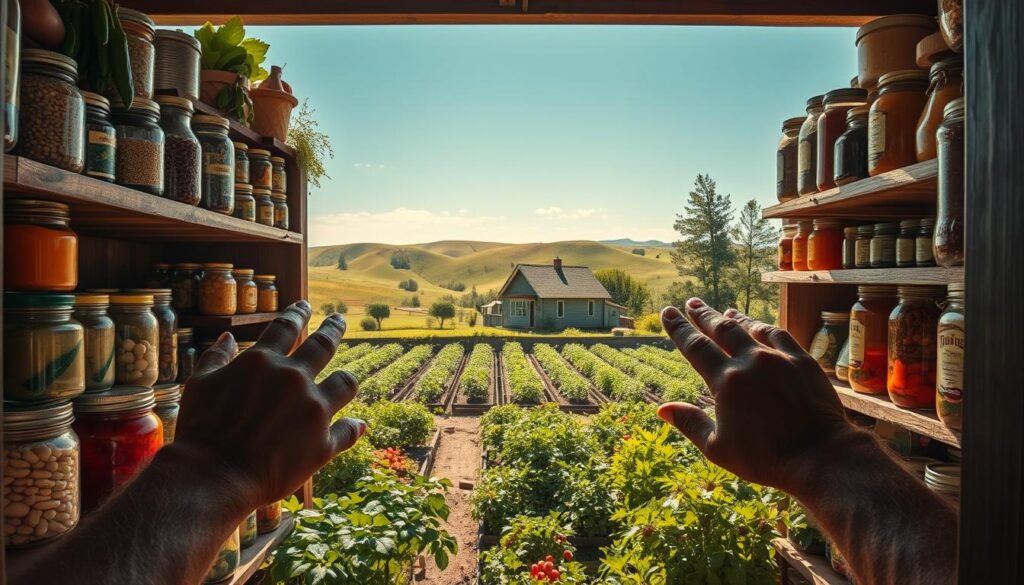
Beyond financial savings, this lifestyle offers significant mental health benefits. A staggering 82% of homesteaders report reduced stress levels. The act of nurturing plants and animals provides a sense of purpose and calm, enriching your daily life.
Homesteading also fosters intergenerational skills transfer. For example, the Nickols Family teaches their children butchery, ensuring valuable knowledge is passed down. This strengthens family bonds while preparing the next generation for a sustainable future.
Success stories like From Scratch Farmstead inspire many. This family produces 80% of their own food, proving that self-sufficiency is achievable. Whether you’re growing herbs on a balcony or raising micro-livestock, this lifestyle can transform your home and life.
Planning Your Small Homestead
Effective planning is the cornerstone of a successful self-sufficient lifestyle. Without a clear strategy, 93% of attempts fail due to poor initial preparation. Whether you’re working with a 1-acre property or a larger plot, thoughtful planning ensures your efforts yield the best results.

Assessing Your Space
Start by evaluating your space. Sun mapping is a simple yet effective technique to determine the best spots for your garden. Track sunlight patterns throughout the day to identify areas with optimal exposure.
Livestock also requires careful consideration. Chickens need just 4 square feet per bird, while goats require 40 square feet. Plan accordingly to ensure your animals thrive without overcrowding.
Setting Realistic Goals
Use the SMART framework to set achievable goals. Specific, Measurable, Attainable, Relevant, and Time-bound objectives keep you on track. For example, aim to grow 50% of your vegetables within a year.
Narrow Gate Homestead is a great example. Over three years, they transformed their 2-acre plot into a thriving, self-sufficient haven. Their journey highlights the importance of patience and adaptability.
“Start with water access before permanent structures. Without it, your plans will stall.”
| Resource | Priority |
|---|---|
| Water Access | High |
| Garden Space | Medium |
| Livestock Area | Medium |
By prioritizing resources and developing essential skills, you’ll lay a solid foundation for your self-sufficient journey. Start small, plan smart, and watch your efforts flourish.
Essential Skills for Small Homesteading
Mastering essential skills is the backbone of a thriving self-sufficient lifestyle. Whether you’re growing plants or preserving food, these competencies ensure your efforts yield the best results. Let’s explore the core skills every beginner should focus on.
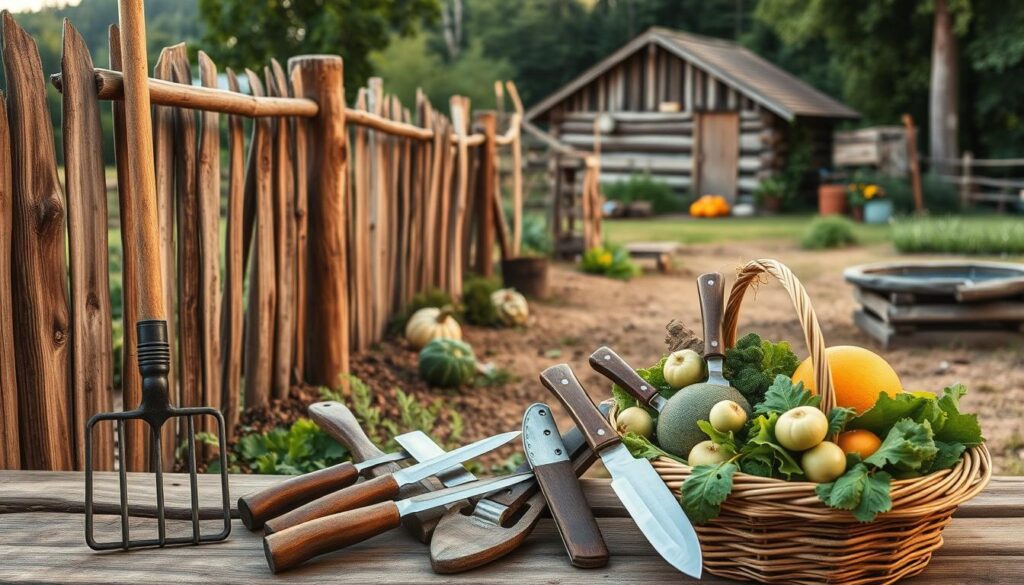
Start with the basics. Gardening is a foundational skill that sets the stage for success. Learn how to rotate crops to maintain soil health and maximize yields. As you progress, delve into animal husbandry, which requires patience and dedication.
Food preservation is another critical skill. Did you know 61% of beginners struggle with this? Understanding the difference between water bath and pressure canning can make all the difference. Proper techniques ensure your food stays safe and delicious throughout the season.
Tool maintenance is often overlooked but equally important. Sharpening hoes and pruning shears keeps your equipment efficient and extends its lifespan. A well-maintained tool saves time and effort in the long run.
Finally, prioritize emergency preparedness. Create a first-aid kit tailored to your needs. This ensures you’re ready for any situation, from minor injuries to unexpected challenges.
| Skill | Year 1 | Year 3 |
|---|---|---|
| Gardening | ✓ | ✓ |
| Animal Husbandry | ✓ | |
| Food Preservation | ✓ | ✓ |
By focusing on these skills, you’ll build a solid foundation for your self-sufficient journey. Start small, stay consistent, and watch your efforts flourish.
Starting a Garden on a Small Homestead
Creating a thriving garden is one of the most rewarding steps toward self-sufficiency. Whether you’re working with a spacious backyard or a compact area, smart planning and the right techniques can maximize your harvest. Let’s explore how to get started.
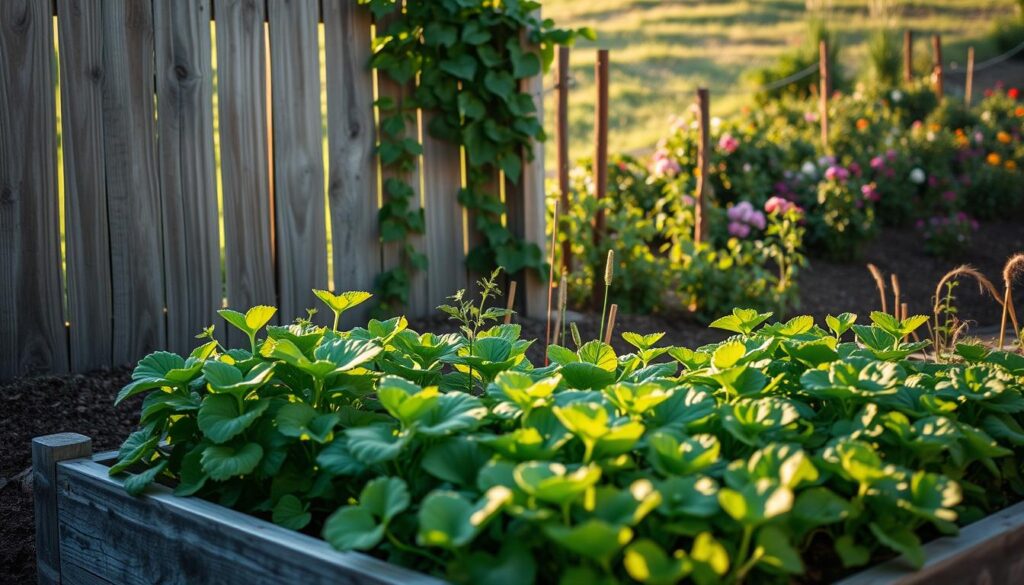
Choosing the Right Plants
Selecting the best plants for your space is crucial. Focus on high-value crops like kale, which can yield up to nine harvests per year. Compare this to corn, which typically offers only a single harvest. Prioritize vegetables that thrive in your climate and soil type for the best results.
Companion planting is another effective strategy. The Three Sisters guild—corn, beans, and squash—is a classic example. These plants support each other’s growth, creating a harmonious and productive garden.
Container and Vertical Gardening
Limited space doesn’t mean limited potential. Container gardening allows you to grow food in repurposed items like bathtubs or fabric grow bags. This method is perfect for urban settings or compact backyards.
Vertical systems, such as cattle panel arches for squash, maximize space efficiency. Square foot gardening, for instance, yields 100% more than traditional rows. These techniques ensure you’re growing food even in the smallest areas.
Succession planting is another key strategy. By scheduling plantings throughout the season, you can enjoy a continuous harvest. This approach keeps your garden productive and your table full of fresh produce.
Raising Animals on a Small Homestead
Raising animals on a limited property can be both rewarding and practical. Whether you’re looking for fresh eggs, meat, or companionship, choosing the right animals ensures success. With proper care and planning, even compact spaces can support thriving livestock.
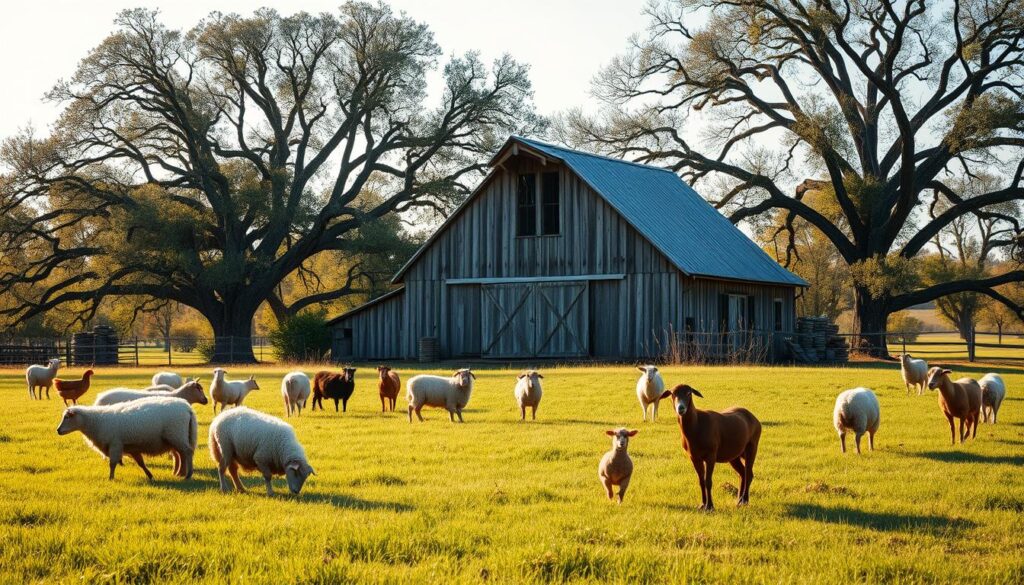
Best Animals for Compact Areas
Not all animals require vast spaces. Quail, for example, need just 1 square foot per bird, making them ideal for tight areas. Chickens, on the other hand, require 4 square feet per bird but are excellent for providing eggs and meat.
Other great options include rabbits and dwarf goats. Rabbits are low-maintenance and produce high-quality meat, while dwarf goats are efficient grazers and provide milk. Choose based on your needs and available space.
Basic Animal Care Tips
Proper care is essential for healthy livestock. Start with predator-proof housing. Use hardware cloth instead of chicken wire for better protection. Ensure coops are clean and well-ventilated to prevent disease.
Feed costs can add up, so consider alternatives like fermented grains, which are cost-effective and nutritious. Manure management is also crucial. Composting systems turn waste into valuable fertilizer for your garden.
“Start with water access before permanent structures. Without it, your plans will stall.”
By focusing on these essentials, you’ll create a sustainable and efficient setup for your home. For more tips, visit New Gen Living.
Making the Most of Your Small Homestead
Maximizing your property’s potential can transform it into a self-sufficient haven. With smart planning and creative strategies, even limited areas can yield impressive results. Here are some ways to make the most of your space.
Multi-function infrastructure is a game-changer. For example, chicken moats not only provide a safe area for your birds but also act as natural pest control for your garden. This dual-purpose setup saves space and boosts productivity.
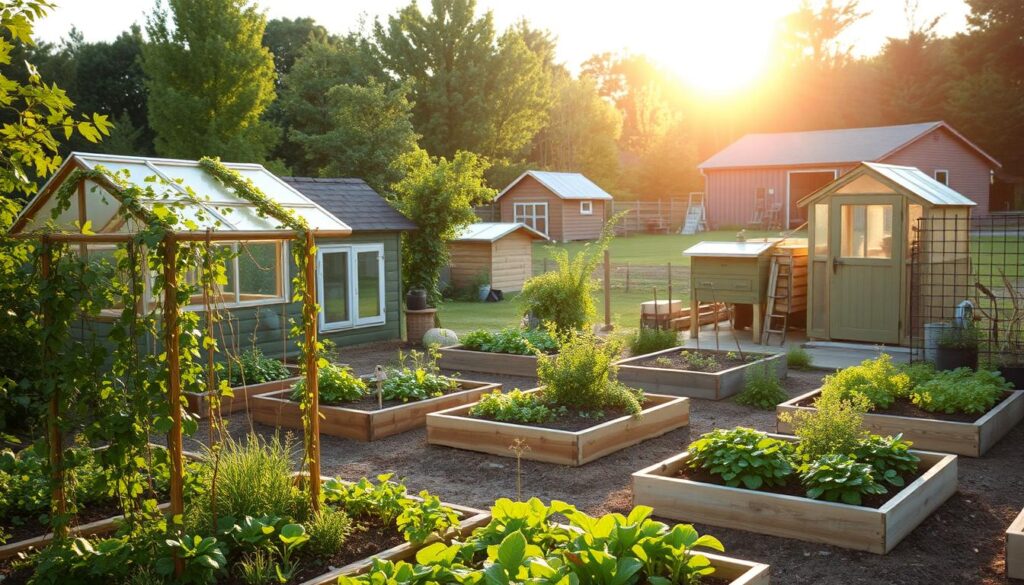
Succession planting ensures a continuous harvest. By rotating crops and scheduling plantings, you can maximize your garden’s output. A simple calendar template can help you stay organized and make the most of your growing season.
Rainwater collection is another efficient strategy. Did you know that just 1 inch of rain can yield 600 gallons of water from a 1,000 sq ft roof? This sustainable method reduces reliance on external water sources and keeps your garden thriving.
Renewable energy options like solar dehydrators and biogas digesters can further enhance your setup. These systems not only reduce utility costs but also align with a sustainable lifestyle.
Permaculture zones are a great way to organize your property. For instance, a kitchen herb spiral design places herbs close to your home for easy access while adding aesthetic appeal. This thoughtful layout ensures every lot of your property serves a purpose.
- Use multi-function infrastructure like chicken moats for pest control.
- Create a succession planting calendar for continuous harvests.
- Harvest rainwater to reduce reliance on external sources.
- Explore renewable energy options like solar dehydrators.
- Design permaculture zones for efficient space use.
By implementing these strategies, you can turn your property into a productive and sustainable haven. Start small, plan smart, and watch your efforts flourish.
Turning Your Small Homestead into a Business
Your land can be more than just a home—it can be a source of income. With creativity and effort, you can transform your efforts into a thriving business. Whether you’re selling fresh produce or handmade items, there are countless ways to monetize your space.
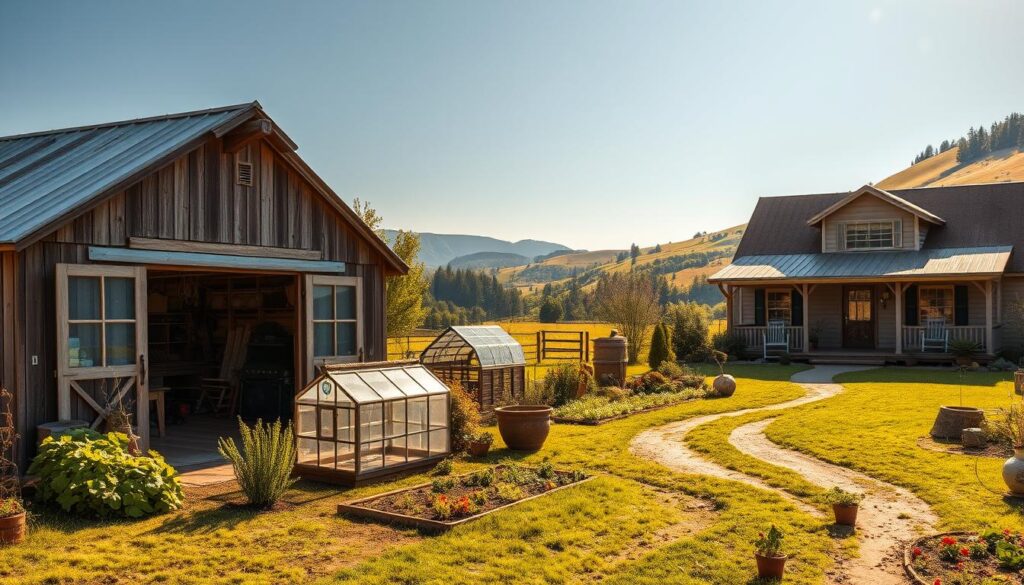
Income-Generating Ideas
Start by exploring value-added products. For example, goat milk soap has a profit margin of up to 70%. Herbal products, like lavender sachets, are also popular. Etsy sellers in this niche average $8,000 per year.
Farmers markets are another great option. A booth can cost $50-$200 per day, but the potential earnings make it worthwhile. Consider offering unique items like organic honey or handmade jams to stand out.
Community Supported Agriculture (CSA) models are gaining traction. Meat shares and veggie boxes provide steady income while building customer loyalty. Compare the benefits of each to find the best fit for your farm.
Marketing Your Homestead Products
Digital marketing is essential for reaching a wider audience. Optimize your website for local searches like “organic lavender sachets near me.” This strategy boosts visibility and attracts customers in your area.
Social media platforms are powerful tools. Share behind-the-scenes content to connect with your audience. Highlight the story behind your products to build trust and loyalty.
“Focus on quality and authenticity. Customers value transparency and are willing to pay for it.”
By combining these strategies, you can turn your homestead into a profitable venture. Start small, stay consistent, and watch your efforts pay off.
Overcoming Challenges in Small Homesteading
Starting a self-sufficient journey comes with its own set of hurdles, but overcoming them is part of the process. Whether you’re dealing with predator attacks or soil depletion, being prepared is key. In fact, 89% of beginners experience predator issues in their first two years. Here’s how to tackle common challenges and keep your efforts on track.
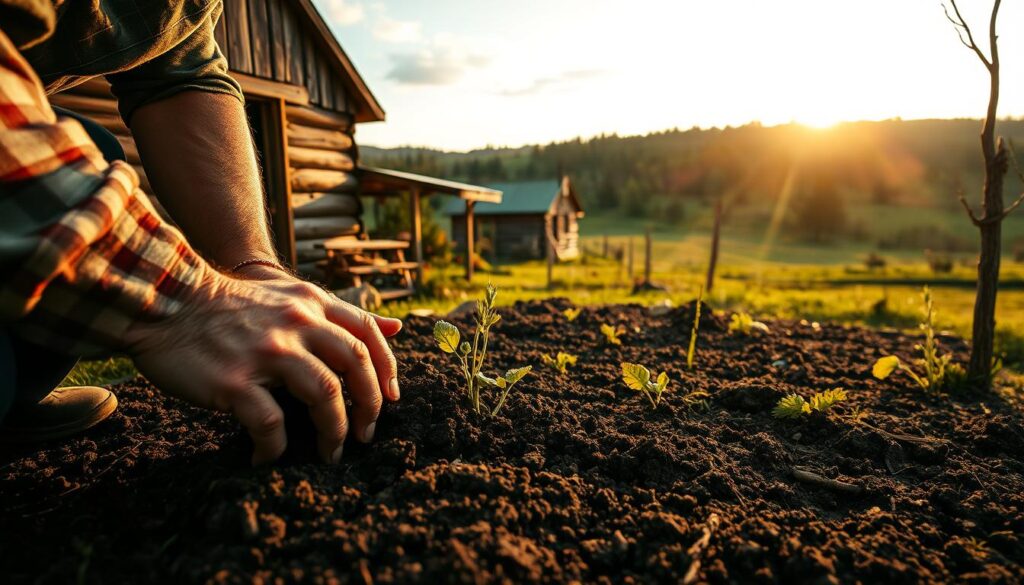
One of the most common pitfalls is soil depletion. Over time, continuous planting can strip the soil of nutrients. Rotate crops and use compost to maintain fertility. Testing your soil annually ensures you’re providing the right balance for healthy growth.
Emergency protocols are essential for unexpected situations. Power outages can disrupt your routine, so having a backup generator or solar panels is a smart move. Store essentials like water and non-perishable food to stay prepared during disruptions.
Mental health is often overlooked but crucial. Burnout can happen when the workload feels overwhelming. Schedule regular breaks and set realistic goals to prevent exhaustion. Remember, progress takes time, and it’s okay to pace yourself.
Building a local network can make a big difference. Connect with other homesteaders to share knowledge and resources. Local groups often offer support during tough times, from crop failures to equipment breakdowns.
Recovering from setbacks is part of the journey. If you face crop loss, replant with resilient varieties. Learn from the experience and adjust your strategies for better results in the coming years.
- Rotate crops and use compost to prevent soil depletion.
- Prepare for power outages with backup systems and stored essentials.
- Prevent burnout by setting realistic goals and taking breaks.
- Join local homestead networks for support and shared knowledge.
- Replant resilient crops after failures to recover and improve.
Real-Life Examples of Small Homesteads
Exploring real-life examples of self-sufficient living can inspire and guide beginners. From urban balconies to rural properties, these stories show how homesteaders thrive with creativity and determination.
Blue Whistler Farm is a standout example. Their sheep dairy operation on 5 acres produces high-quality milk and cheese. This setup proves that even modest spaces can support profitable ventures.
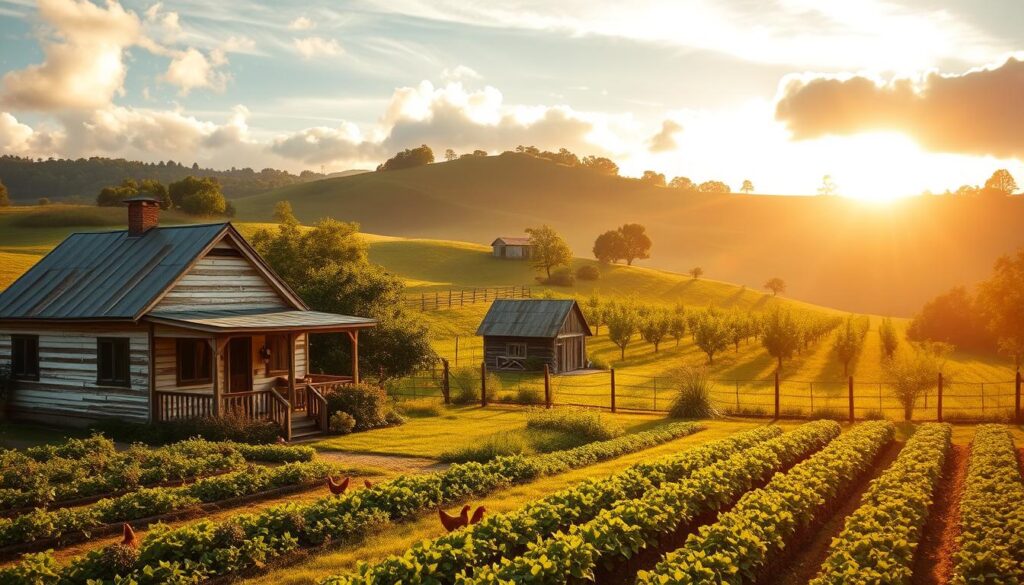
Nest in the West demonstrates the potential of compact land. Their 2-acre property features a 25-tree orchard, yielding fresh fruit year-round. This family shows how thoughtful planning maximizes productivity.
Urban dwellers can also embrace this lifestyle. One homesteader transformed their apartment balcony into a microgreens operation. This innovative approach provides fresh greens while saving space.
From Scratch Farmstead offers a financial blueprint. Their diverse income streams include selling produce, eggs, and handmade goods. This model highlights the economic potential of self-sufficiency.
Narrow Gate Homestead excels in adaptive reuse. Their barns are built from scrap materials, reducing costs and waste. This resourcefulness inspires others to think creatively.
The Nickols family showcases the power of mentorship. Their multi-generational program teaches essential skills, ensuring knowledge is passed down. This approach strengthens bonds while preparing the next generation.
| Homestead | Key Feature |
|---|---|
| Blue Whistler Farm | Sheep dairy on 5 acres |
| Nest in the West | 25-tree orchard on 2 acres |
| Apartment Microgreens | Balcony operation |
| From Scratch Farmstead | Diverse income streams |
| Narrow Gate Homestead | Scrap material barns |
| Nickols Family | Multi-generational mentorship |
These examples prove that self-sufficient living is achievable, regardless of space or location. Learn from their experiences and start your journey today.
Resources for Small Homesteaders
Finding the right tools and support can make your journey easier and more rewarding. Whether you’re just starting or looking to expand, having access to reliable resources is essential. Here’s a guide to help you navigate the tools, education, and funding options available for homesteaders.

Start with the basics. A broadfork is a great alternative to a rototiller for maintaining soil health. It’s less disruptive and more sustainable for your garden. Compare the pros and cons to choose the best tool for your needs.
Education is another key factor. Platforms like Farmstead U offer online courses tailored to beginners. These programs provide valuable knowledge on everything from gardening to animal care.
Funding can be a challenge, but there are options. The USDA offers beginner farmer grants to help you get started. Research eligibility requirements and apply to secure financial support for your projects.
Equipment sharing is a smart way to save money. Many states have tool libraries where you can borrow essential items. This not only reduces costs but also fosters a sense of community among homesteaders.
Legal considerations are also important. Use templates like livestock liability waivers to protect yourself and your property. These documents ensure you’re prepared for any situation.
- Essential tools: Broadfork vs rototiller comparison
- Education platforms: Farmstead U online courses
- Funding sources: USDA beginner farmer grants
- Equipment sharing: Tool libraries by state
- Legal templates: Livestock liability waivers
By leveraging these resources, you can build a strong foundation for your self-sufficient lifestyle. Start with this list, and explore additional options to support your journey.
Conclusion
Your journey toward self-sufficiency begins with a single step, and every milestone counts. From planting your first garden to earning your first profit, each achievement brings you closer to your goals. Remember, progress doesn’t happen overnight—focus on mastering one skill per season.
Stories of transformation over five years inspire us all. Families who started with just a few plants now thrive with thriving gardens and livestock. Their success shows that with dedication, even beginners can achieve remarkable results.
Ready to take the next step? Join a local homesteading co-op to connect with like-minded individuals. Sharing knowledge and resources can make your journey smoother and more rewarding.
As Amy from Blue Whistler Farm says, “Start where you are, use what you have, and do what you can.” This guide is your roadmap—now it’s time to begin your adventure.

